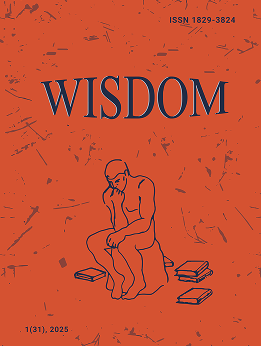Features of Cross-Cultural Dialogue in the Context of the Problem of National Self-Consciousness
DOI:
https://doi.org/10.24234/wisdom.v2i1.28Keywords:
National self-identity, nation, ethnic groups, multinationality, mono-ethnic, inter-cultural dialogueAbstract
The modern world has reached a stage of development which implies a new level of communication between people, and between societies. This has led humanity to unprecedented changes in the area of intercultural communication, and therefore requires new approaches in relation to the investigation and analysis of coexistence phenomena (such as conflict and peace), carries of different cultural systems. Challenges posted by modern trends of globalization, are imposing to all the states the activation of inter-ethnic relations and communication, and this leads to the formation of a common cultural environment. In multiethnic societies reveals a variety of opportunities to communicate with different people, which provides good ground for knowledge about the differences and features, as their own ethnic group and other ethnic groups, and of course, are formed and developed the skills of intercultural communication. An important factor of this cross-cultural communication is becoming a national or ethnic self-consciousness, which differs from the other elements of intercultural dialogue, by the fact that on the one hand – on the way to the integration of multiethnic society, the individual consciously or unconsciously (for himself and others) is perceived as a member of a concrete ethnic group. On the other hand – national self-consciousness most strongly and more clearly distinguishes from each other the sides of cross-cultural dialogue.
Downloads
References
2. ???????????, ?.?. (2002). ???????????????? ????????????. ????? ??????????? ??????? ? ??????????????. ???.???. «???????».
3. ???????, ?.?. (2008). ????????? ? ????????????? ?????????. ???.???. «???¬???-???????».
4. ???????, ?.?. (2008). «???????????? ??????????? ????????????? ??????: ?????????-????????????????? ?????? ????????????????? ????????».// ??????????????? ???????? ?????????????. ? 4 ?????, ??? II: ???????????? ?????????????. /???. ???. ?????? ?.?./ ???.???. «???????».
5. ???????, ?.?. (1993). ?????????? ? ?????????? ???????????? ?????????. ???. ???. «?.?.?????????».
6. ?????, ?.?. (1997). ??????????? ?????????. ??????, ???. «?????? ?????».
7. ??????, ?.?. (2000) «????? ??????????? ?? ????????? ???, ???????????? ???¬???? ???????????». ???-????/ http://iran.ru/rus/knigakhatami.php/.
Downloads
Published
How to Cite
Issue
Section
License
Creative Commons Attribution-Non-Commercial (CC BY-NC). CC BY-NC allows users to copy and distribute the article, provided this is not done for commercial purposes. The users may adapt – remix, transform, and build upon the material giving appropriate credit, and providing a link to the license. The full details of the license are available at https://creativecommons.org/licenses/by-nc/4.0/.















